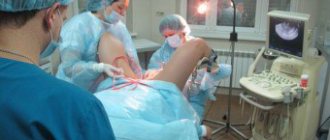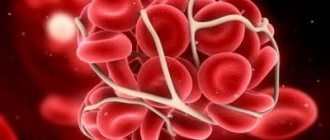Leukocytosis during pregnancy
(ICD-10 classification R70-R79) is a condition of the body in which the concentration of white blood cells (leukocytes) in the bloodstream increases. Every pregnant woman regularly undergoes a blood test, which shows not only the hemoglobin level, but also the number of leukocytes - it is important that the leukocytes in the blood are not increased or decreased, as this is evidence of pathology. Normally, the level of white blood cells can fluctuate from 4 to 8.8 × 109/l, but in pregnant women it is considered normal to increase leukocytes in the blood to 11 × 109/l.
A slight increase in the number of white blood cells during pregnancy indicates activation of the immune system, an increase in the erythrocyte sedimentation rate and slight thickening of the blood. In cases where leukocytes in the blood increase significantly, leukocytosis develops, which indicates the presence of inflammatory processes or other pathologies in pregnant women that require immediate treatment.
Causes of low lymphocytes and increased neutrophils
Typically, low lymphocytes and high neutrophils are caused by various pathologies and viruses.
It is understood that in both the first and second cases the factors of deviation from the norm will be different. So, an increase in neutrophils usually occurs due to the following factors:
acute infections caused by bacteria, which are accompanied by a purulent-inflammatory process:
- localized. Observed with moderate neutrophilia with certain manifestations (abscesses, infections of the ENT organs, appendicitis, pneumonia, tuberculosis, acute tonsillitis, diseases of the genitourinary organs and others);
- generalized. For severe neutrophilia (sepsis, peritonitis (inflammation of the peritoneum), infectious diseases such as cholera or scarlet fever).
- necrosis and necrotic lesions (myocardial infarction, stroke, gangrene, severe burns);
- recent vaccination;
- effects on the bone marrow of toxic substances (alcohol, lead);
- bacterial toxicosis without infection directly by bacteria (for example, when there were unbroken botulinum toxins in the food, and the bacteria themselves had already become inactive);
- the disintegration of a malignant neoplasm is a process in which damaged cells stop growing and begin to be excreted naturally.
In turn, a decrease in lymphocytes most often indicates the following problems.
- Miliary tuberculosis (hematogenous, usually generalized form of tuberculosis, accompanied by a dense rash of small tuberculous tubercles in the lungs).
- Tuberculosis of the bronchial glands.
- Hematological diseases of lymphatic tissue (lymphoma, lymphosarcoma).
- Exposure of the body to different types of ionizing radiation. Severe health effects, such as skin burns or radiation sickness, can occur when the radiation dose crosses certain limits.
- Multiple myeloma is a malignant neoplasm of plasma cells, which is mainly localized in the bone marrow.
- Aplastic anemia is a disease of the hematopoietic system. With this disease, the bone marrow basically stops producing different types of blood cells, including red blood cells, platelets, and white blood cells in the required quantities.
- The use of glucocorticoids are steroid hormones from the subclass of corticosteroids produced by the adrenal glands.
- AIDS, a condition that progresses due to HIV infection and is characterized by a decrease in T-lymphocytes and multiple opportunistic diseases.
- Renal failure is a dysfunction of the kidneys. The decrease can occur in both acute and chronic forms of renal failure.
- Systemic lupus erythematosus is a serious illness during which the human immune system mistakes its own cells for foreign agents and begins to fight them.
- Lymphogranulomatosis is a malignant disease of lymphatic tissue, accompanied by the presence of huge Reed-Berezovsky-Sternberg cellular structures, which are identified during a microscopic examination of the affected lymph nodes.
Based on the reasons described above, if the levels of segmented neutrophils are increased and lymphocytes are decreased, this most likely indicates the presence of a viral infection or the development of inflammation. In this case, you need to immediately consult a doctor and undergo treatment.
What does rising values mean?
An increase in blood white blood cells during pregnancy may indicate the following problems:
- penetration of pathogenic organisms - bacteria or viruses - into the female body;
- development of diseases accompanied by purulent inflammatory processes (angina, appendicitis);
- inflammation of the vagina caused by infection.
In any case, the situation is alarming . It is imperative to undergo a thorough examination, determine the cause and undergo adequate treatment.
Increased leukocytes in the blood after childbirth - causes of leukocytosis
Increased leukocytes in the blood after childbirth - many people encounter this problem. There are physiological and pathological reasons for this deviation.
In the first case, the situation can normalize on its own, in the second, it cannot be done without the help of a specialist. Childbirth is a great stress for the body. All systems and organs in the postpartum period are in a weakened state.
Therefore, a woman should carefully monitor her health and undergo tests in order to notice the development of pathology in time.
General concepts
White blood cells are called leukocytes. They protect the body from the negative effects of viruses and bacteria. These cells have the ability to promptly recognize a foreign microorganism in the human body and eliminate it.
There are several types of leukocytes, and they all form human immunity. It is by the level of these cells that a specialist can judge the patient’s health status.
With any changes in the state of the body, the level of white cells increases.
This may happen:
- at high ambient temperatures;
- after eating a significant amount of food;
- for any overload - emotional and physical;
- during pregnancy and after the birth of the child.
Such increases are called physiological.
More dangerous is the increase in the concentration of leukocytes in the blood, which occurs due to infection in the body.
That is why the study of leukocytes is a standard diagnostic test.
This procedure helps to detect in time the presence of serious pathological processes in the body, which is very important, especially in the postpartum period. Women in this position are advised to undergo periodic testing
Physiological causes of postpartum leukemia
Giving birth to a child is a very difficult and exhausting process for every woman. The body prepares for this event from the first to the last day of pregnancy.
Before birth, the following changes occur in the hematopoietic system:
- The amount of blood is increased to prevent possible bleeding.
- Leukocytes accumulate in the uterine area to prevent infections and stimulate uterine contractility. Therefore, during childbirth, an upward deviation in the leukocyte count may be observed.
- During labor, white blood cell counts may rise to more than twenty percent of normal values.
A high level of white cells is the body's natural response to the physical and psychological stress that occurs during labor.
After the birth of a child, the level of cells does not fall, as there is increased production of blood cells and tissue healing.
A high level of leukocytes is observed in women who lost a large amount of blood during the birth of a child if they had a cesarean section rather than a natural birth. Within a week, the blood condition should be restored.
Pathological causes
Some women may wonder why leukocytes in the blood are elevated after childbirth, if some time has already passed. The reasons for this may be postpartum complications.
Leukocytes may increase after childbirth if an infectious-inflammatory process has begun in the body.
Pathogenic microorganisms can enter the body:
- with severe blood loss;
- due to the fact that the immune system has been weakened;
- as a result of a lack of certain vitamins in the body;
- with anemia;
- due to disturbances in the coagulation system;
- through nipple cracks:
- during severe pregnancy and complicated childbirth.
In women after childbirth, a high level of leukocytes may indicate the development of the following pathologies:
- Inflammatory processes in the uterus.
- With chorioamnionitis, the amniotic fluid may become inflamed.
- Postpartum mastitis, that is, inflammation of the mammary glands.
- Lactostasis.
- Infectious and inflammatory processes in the kidneys.
- Postpartum cystitis.
- Infection in the seams or cracks in the nipples.
- Septic shock.
With such problems, it may not only be leukemia.
These conditions are accompanied by unpleasant symptoms, the presence of which should be a reason to consult a doctor and conduct additional examinations.
Prevention
First of all, prevention involves preventing inflammatory processes in the urogenital tract. In order to avoid leukocyturia and other pathologies of the urogenital tract during pregnancy, the following recommendations should be followed.
- Perform urine tests systematically.
- Treat infections and inflammation of the urogenital tract in a timely manner.
- Eliminate physical and mental fatigue and stress.
- Avoid hypothermia.
- Follow a diet, work and rest schedule, and engage in adequate physical activity.
- Do not allow the bladder to overflow for a long time, which promotes the growth of bacteria.
If you feel unwell, especially during pregnancy, it is recommended to consult a specialist and undergo the necessary diagnostics. Delay is fraught with the development of various consequences, for example, infection of the membranes, miscarriage and premature birth.
How to treat
If an increase in leukocytes in the blood is detected during pregnancy, contact a gynecologist. The doctor conducts an examination and selects an effective treatment method.
Therapy is aimed at eliminating the reasons why leukocytes in the blood increase in pregnant women. Only after this can you begin to normalize your blood composition.
Medication
The choice of medications depends on the cause of leukocytosis:
- Mononucleosis, respiratory infections. Antiviral agents that have an immunostimulating effect are prescribed. Rectal suppositories Viferon and Genferon are considered safe for pregnant women. They are administered 2 times a day for a week. Additionally, antiseptic throat sprays (Ingalipt) and nasal rinses (Aqualor) are prescribed.
- Cystitis, pyelonephritis. In this case, antibiotics and uroseptics are prescribed. The following drugs are approved for use during pregnancy: Monural, Nitrooxoline, Furagin. An effective herbal remedy for treating cystitis is Canephron. The drug eliminates signs of inflammation, spasms and pain. The destruction of pathogenic microorganisms helps to normalize the leukocyte formula.
- Bacterial lesions of the respiratory system. If an increase in leukocytes in the blood is caused by a sore throat, bronchitis or sinusitis, penicillin antibiotics (Zinnat, Hemomycin) are used. Antibacterial agents of the cephalosporin group are rarely prescribed to pregnant women.
- Intestinal infection. In this case, the treatment regimen includes antibacterial agents containing nifuroxazide (Stopdiar, Enterofuril). Additionally, sorbents (Polysorb), saline solutions (Regidron), and antiemetics (Motilium) are prescribed.
Diet
There are foods that can change the number of white blood cells in the blood. Distortion of test results is observed within 2-3 days after eating. Such products include fermented milk products. Most women try to consume as much cottage cheese, kefir and cheese as possible, which contain elements necessary for building the skeletal system of the fetus. These foods should be eaten in moderation.
A temporary increase in the level of leukocytes in the blood is facilitated by the consumption of carrots, buckwheat and oatmeal, grapes and seafood. It is impossible to completely refuse such food.
Folk remedies
If the level of leukocytes in pregnant women is high, the following folk recipes can be used:
- Oat milk drink. Oat grains are cleaned and washed thoroughly. 200 g of raw materials are poured into 2 liters of milk. The mixture is boiled over low heat for 20-30 minutes. The product is consumed 1 glass 2 times a day.
- Chamomile and linden decoction. Dry herbs are ground to a powder. 2 tbsp. l. collection is poured with 1 glass of hot water. The mixture is simmered over low heat for 10 minutes. The finished broth is filtered and taken 200 ml 3 times a day.
- Sloe fruit drink. Finely chop 1 kg of berries and pour 0.5 liters of boiling water. After a day, add 200 g of sugar or honey to the mixture. The mass is boiled over low heat for half an hour, then filtered. The resulting liquid is consumed 50 ml 3 times a day.
Indicators are normal
When assessing a urine test, the doctor compares the indicators and the norm. Normally, the number of leukocytes in the field of view of the microscope should not exceed more than 5 units. This rule also applies to pregnant women. However, an increase in indicators up to 7 units is allowed, especially in the early stages. An increase in leukocytes in the urine may be associated with the body’s reaction to pregnancy, in particular, due to a decrease in physiological immunity.
The normal number of leukocytes in women, according to Nechiporenko’s analysis, is no more than 4000 per 1 ml. During pregnancy, the indicator is often at the upper limit of normal, which is due to the specific physiological state.
Symptoms
This condition cannot be called an independent disease. The fact is that its symptoms closely intersect with many other processes in the body. And finally, the symptoms completely depend on the problem as a result of which the level of blood cells has changed.
In children, this condition is generally asymptomatic. Therefore, doctors recommend that parents undergo blood tests for examination as often as possible. This will allow you to notice the deviation at an early stage. After all, the most dangerous manifestation of this condition is a malignant neoplasm.
A pregnant girl may also not feel any symptoms. But still, when the level of leukocytes jumps, there is a certain discomfort. Weakness, fatigue, high temperature, and increased sweating may occur. Hemorrhages, bruises, and hemorrhages often occur. A woman may experience dizziness, fainting, and difficulty breathing. If you experience such symptoms, you should immediately consult a doctor.
First signs
This condition is most often accompanied by a number of symptoms. It is characterized by malaise, fatigue and mild hyperthermia. Often a woman suffers from excessive sweating, as well as dizziness. There is a loss of appetite. In some cases, decreased vision and sleep disturbances may occur. Possible weight loss, pain in joints and muscles.
All of the above signs are closely related to serious abnormalities in the body. They can be caused by the presence of many inflammatory processes. The true cause can be diagnosed only after certain diagnostic studies are carried out. Of particular danger among all the signs is an increase in temperature. This process indicates the presence of inflammation.
There are also cases when the problem does not manifest itself in any way, but at the same time it exists. Everything appears due to certain deviations, but after some time everything can improve on its own. Treatment is not necessary.
Role and functions
Leukocytes (white blood cells) have a serious function in the body. It consists of resisting harmful agents - viruses, bacteria, allergens and cancer cells.
They play a special role during pregnancy, when the female body undergoes great changes and becomes most vulnerable to all kinds of inflammatory and infectious diseases.
Leukocyte cells protect the body by recognizing and destroying pathogenic microorganisms.
Diagnostic information content
The fact of an increase or decrease in the level of leukocytes during pregnancy is an extremely important indicator reflecting the development of negative processes.
By determining the level of leukocytes it is possible to:
- identify the cause of the pathology and the stage of its development;
- outline therapeutic tactics;
- assess the degree of risk to the health of the patient and her fetus.
That is why ignoring the indications for taking laboratory tests on time is extremely dangerous for the woman herself and her unborn child.
Treatment of leukocytosis
The choice of treatment for leukocytosis depends on what exactly caused it.
Antibiotics are prescribed to treat and prevent the infection that caused leukocytosis
Sometimes this is just a precaution, and in some cases antibiotics help prevent sepsis; Steroid medications are used to relieve or reduce inflammation and thus reduce the number of white blood cells in the blood; Antacids help reduce the amount of acid in the urine while treating leukocytosis; Drugs that reduce uric acid levels. Reducing the volume can prevent the destruction of body tissue, which sometimes results in leukocytosis.
Treatment for leukocytosis is based on the patient's symptoms and history.
Leukocytosis in newborns includes treatment of the underlying infectious disease with the prescription of antibiotics. Although there are cases when the child’s body begins to respond to treatment, reducing symptoms, thus returning leukocytes to normal levels is a little more difficult. In case of a cold, treatment for the disease itself should be started in a timely manner, and the leukocytes will normalize on their own after a certain time.
It is possible, simultaneously with competent drug treatment, to treat leukocytosis with folk remedies. The most effective method is a decoction of lingonberries and their leaves. For example, one spoon of berries and leaves is poured with boiling water and boiled for 15 minutes. Then the resulting broth must be filtered. It is recommended to drink no more than three times a day. You can also brew white birch buds for 30 minutes at the rate of one tablespoon per glass of water. The decoction is taken no more than four times a day. The decoction of strawberries and leaves must be poured with boiling water and cooked for no more than 5 minutes. All decoctions have a positive effect on the general condition of leukocytosis.
The method of treating leukocytosis completely depends on the disease that accompanied its occurrence. A course of drug therapy will be prescribed after a complete diagnosis. Prescribed antibiotics are aimed at treating and preventing infection and preventing the development of sepsis. To reduce or eliminate the inflammatory process, steroids are prescribed to reduce the level of white blood cells. In order to reduce the level of acid in the urine, antacids are prescribed. In case of an allergic reaction, antihistamines may be prescribed.
In rare cases, excess white blood cells are removed using leukapheresis. Doctors will either deliver the leukocyte concentrate obtained as a result of the procedure to the donor center or infuse it back into the patient. Drugs may also be prescribed to prevent the tissue destruction that leukocytosis provokes.
If leukocytosis is detected during pregnancy, specialists prescribe treatment aimed at eliminating the cause of its occurrence. If there is an infectious disease and treatment with already prescribed medications is ineffective, antibiotics will be prescribed that are appropriate for the duration of pregnancy without harm to the child. Drugs are selected for each woman individually, taking into account the sensitivity of the pathogen to drugs. If the pathogen cannot be determined, then treatment will not give any results. In case of proper treatment and exactly followed recommendations, a woman will be able to protect not only herself, but also her child. In this case, the use of folk remedies is strictly prohibited.
It is also necessary to take into account that refusal of medications during pregnancy can provoke prolonged inflammatory processes that will lead to serious consequences. A disease that will progress in the body of the expectant mother can terminate the pregnancy or create complications
It is for this reason that treatment of leukocytosis in pregnant women is extremely important.
An important stage in the treatment process is proper individual nutrition. In the case of a low level of leukocytes, the diet should be enriched with foods that stimulate the production of hemoglobin. It is best to eat foods enriched with vitamin B9, legumes, and drink milk. You should also limit your consumption of meat products, completely excluding kidneys and liver.
Description and standards
Many norms for indicators during pregnancy differ from similar indicators in non-pregnant women, men and children. That is why a blood test, regardless of its purpose and type, should be assessed using special tables and standards designed exclusively for pregnant women.
Clinical blood test - table of norms during pregnancy
Standards and deviations:
| The indicator determined during the study | Normal value in 1st trimester | Normal value in 2nd trimester | Normal value in the 3rd trimester |
| Red blood cells | 3.5x10^12 – 5.6x10^12 units | 3.5x10^12 – 5.6x10^12 units | 3.5x10^12 – 5.6x10^12 units |
| 112-160 g/liter | 108-144 g/liter | 100-140 g/liter | |
| Hematocrit | 31-49% | 31-49% | 31-49% |
| Color index | 0.85-1.1 units | 0.85-1.1 units | 0.85-1.1 units |
| Reticulocytes | 0,2-1,5% | 0,2-1,5% | 0,2-1,5% |
| Platelets | 140x10^9 - 400x10^9 units/liter | 140x10^9 - 400x10^9 units/liter | 140x10^9 - 400x10^9 units/liter |
| Leukocytes | 4x10^9 - 9x10^9 units/liter | Not higher than 11x10^9 units/liter | Not higher than 15x10^9 units/liter |
| Band neutrophils | 1-6% | 1-6% | 1-6% |
| Segmented neutrophils | 40-78% | 40-78% | 40-78% |
| Myelocytes | 0-3% | 0-3% | 0-3% |
| Lymphocytes | 18-44% | 18-44% | 18-44% |
| Monocytes | 1-11% | 1-11% | 1-11% |
| Eosinophils | 0-5% | 0-5% | 0-5% |
| Up to 60% (45 mm per hour) | Up to 60% (45 mm per hour) | Up to 60% (45 mm per hour) |
Biochemical blood test - table of normal values for pregnant women
Standards and deviations:
| Defined indicator | Normal value for the first trimester | Normal value for the second trimester | Normal value for the third trimester |
| General | 63-83 g/l | 63-83 g/l | 63-83 g/l |
| Albumen | 32-50 g/l | 28-55.7 g/l | 25.6-66.0 g/l |
| Urea | 2.5-7.1 mmol/liter | 2.5-7.1 mmol/liter | 2.5-6.2 mmol/liter |
| Cholesterol (cholesterol) | 6.16-13.7 mmol/liter | 6.16 -13.7 mmol/liter | 6.16 -13.7 mmol/liter |
| Globulin | 28-112 g/l | 28-112 g/l | 28-112 g/l |
| Sugar (glucose) | 3.5 – 5.83 mmol/liter | 3.5 – 5.83 mmol/liter | 3.5 – 5.83 mmol/liter |
| Creatinine | 32-70 µmol/liter | 32-50 µmol/liter | 32-47 µmol/liter |
| Diastasis | 25-125 units/l | 25-125 units/l | 25-125 units/l |
| ALT | No more than 32 units/l | No more than 31 units/l | No more than 31 units/l |
| AST | No more than 31 units/l | No more than 30 units/l | No more than 30 units/l |
| GGT | No more than 36 units/ml | No more than 36 units/ml | No more than 36 units/ml |
| Total bilirubin | 3.4 -21.6 µmol/liter | 3.4 -21.6 µmol/liter | 3.4 -21.6 µmol/liter |
| Direct bilirubin | No more than 7.9 µmol/liter | No more than 7.9 µmol/liter | No more than 7.9 µmol/liter |
| Indirect bilirubin | 3.4-13.7 µmol/liter | 3.4-13.7 µmol/liter | 3.4-13.7 µmol/liter |
| Alkaline phosphatase | 40-150 units | 40-190 units | 40-240 units |
| Iron | 8.93-30.4 µmol/liter | 8.93-30.4 µmol/liter | 7.2-25.9 µmol/liter |
| Sodium | 135-155 mmol/liter | 135-145 mmol/liter | 135-155 mmol/liter |
| Chlorine | 98-107 mmol/liter | 98-107 mmol/liter | 98-107 mmol/liter |
| Potassium | 3.4-5.3 mmol/liter | 3.4-5.5 mmol/liter | 3.4-5.3 mmol/liter |
| Phosphorus | 1.0-1.57 mmol/liter | 1.0-1.40 mmol/liter | 0.87-1.47 mmol/liter |
| Magnesium | 0.85-2 mmol/liter | 0.85-1.7 mmol/liter | 0.85-1.4 mmol/liter |
Standards and deviations:
| Human chorionic gonadotropin hCG | Protein PAPP-A |
| 0.5 - 2.0 MoM | 0.5 -2.0 MoM |
Second trimester screening - triple test (weeks 16-19)
Standards and deviations:
| hCG | Free estriol | |
| 10,000-58,000 mU/ml or 0.5 - 2.0 MoM | 15-95 units/ml or 0.5 - 2.0 MoM | 15-16 weeks – 5.4-21 nmol/l; 17-18 weeks – 6.6-25 nmol/l; 19-20 weeks – 7.5-28 nmol/l. |
Coagulogram
Standards and deviations:
| The indicator determined during the study | significance for pregnant women |
| APTT | 17-20 seconds |
| Prothrombin level | 80-140% |
| Platelet count | 131x 10^9 – 402 x10^9 units/liter |
| No more than 6.4 g/l | |
| Thrombin time | 9.5 - 18 seconds |
| Antithrombin -3 | 70-120% |
| Lupus anticoagulant | Not detected |
Promotion
The most elevated level of leukocytes in the blood is provoked by a number of factors, the cause of which is:
- allergy;
- intoxication;
- all types of anemia;
- renal failure;
- burns;
- deep wounds;
- heavy bleeding;
- inflammatory diseases of the body.
Also, an increase in the level of leukocytes in the blood can occur during:
- overvoltage;
- emotional performance;
- physical performance;
- after eating.
A blood test for the number of leukocytes is prescribed in the morning on an empty stomach. Before diagnosis, you should put your emotional state in order, calm down, and not overheat.
Any psychological stress can lead to an increase in leukocytes
Why do expectant mothers have increased white blood cells?
During pregnancy, women systematically donate blood for analysis in order to identify pathologies and receive timely help.
Doctors pay special attention to such an indicator as leukocytes
It is important that their level is not high or low
Increases in white cell levels during pregnancy may be physiological or pathological. In the first case, this condition is due to the following reasons:
- eating;
- taking a hot or cold shower;
- emotional excitement;
- excessive physical activity;
- the pregnancy itself.
The increase in white blood cells during pregnancy is due to the fact that during this period white cells accumulate in the submucous uterine lining. This usually occurs in the second trimester and stimulates the contractile function of the reproductive organ and prevents infection from penetrating the fetus.
Thus, leukocytosis not caused by a disease does not require treatment. This is a typical increase in immune defense during pregnancy. The total white blood cell count increases by about 20 percent. At the same time, the level of different types of white cells changes differently. The leukocyte formula of a pregnant woman is as follows:
- band neutrophils are increased;
- segmented neutrophils are increased in absolute value;
- lymphocytes are moderately reduced both in number and percentage;
- eosinophils are reduced both in number and percentage.
Leukocytosis during pregnancy can be both physiological and pathological
If the level of white cells is above 10X10⁹/liter, then we are talking about leukocytosis, which is considered a pathological condition. The causes are various inflammatory diseases. These include:
- Respiratory tract infections such as pneumonia, bronchitis. The main symptoms of these diseases are cough and fever.
- Acute bacterial infections accompanied by high fever: cholecystitis, pyelonephritis, appendicitis.
- Purulent processes in which the level of white cells rises to 50X10⁹/liter. This is an abscess, blood poisoning, peritonitis.
- Meningitis is an inflammation of the meninges.
- Otitis media, characterized by fever, ear pain, ear discharge, and hearing loss.
- Significant blood loss.
- Anemia.
- Kidney failure.
- Hepatitis.
- Allergic reactions.
- Intestinal inflammation.
- Long-term use of medications.
- Rubella, measles, malaria, typhoid fever.
- Rheumatoid arthritis.
- Poisoning.
- Exacerbations of chronic diseases.
- Tissue damage due to injuries and surgical interventions.
- Severe burns.
- Oncological diseases.
- Lupus erythematosus.
Possible complications
The consequences for the child can be unpredictable and negative even in the case of a slight deviation from the norm.
Among the most likely complications are:
- Delivery ahead of schedule.
- Miscarriage.
- Developmental anomaly.
- Congenital diseases.
Despite the fact that an increase in white blood cells during pregnancy is considered an acceptable norm, you should undergo timely preventive examinations, do regular tests and follow the recommendations of a competent doctor in everything.
The doctor will choose the correct treatment tactics if necessary. This will allow you to safely carry and give birth to a healthy baby, as well as avoid unwanted complications.
Upon receipt of the examination results, it may be discovered that leukocytes in the blood are elevated during pregnancy. This class of blood cells includes many subtypes responsible for various functions of the immune system. Changes in blood composition can be observed during infections, exacerbation of chronic diseases, or the influence of certain physiological factors.











